
Grevillea miniata, commonly known as sandstone grevillea, is a species of flowering plant in the family Proteaceae and is endemic to north-western Australia. It is a spreading to erect shrub or small tree with more or less oblong leaves and bright yellow to orange and bright red flowers with a yellow style.
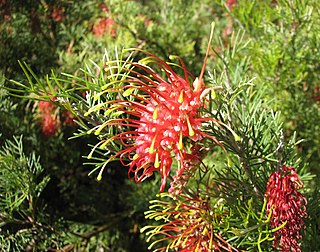
Grevillea thelemanniana, commonly known as spider net grevillea, is species of flowering plant in the family Proteaceae and is endemic to Perth, Western Australia. It is a spreading shrub with linear and pinnatipartite to pinnatisect leaves with linear to narrowly elliptic lobes, and clusters of 6 to 14 pinkish-red and cream-coloured flowers with a red, green-tipped style.

Grevillea crithmifolia is a species of flowering plant in the family Proteaceae and is endemic to the south-west of Western Australia. It is a dense shrub with linear leaves, divided leaves with narrowly oblong lobes, or both, and clusters of pale pink to creamy-white flowers.

Grevillea olivacea, commonly known as olive grevillea, is a species of flowering plant in the family Proteaceae and is endemic to the west coast of Western Australia. It is a dense, erect shrub with elliptic to egg-shaped leaves, and erect clusters of bright red and orange or yellow flowers with a red to yellow style.

Grevillea obtusifolia, commonly known as obtuse leaved grevillea, is a species of flowering plant in the family Proteaceae and is endemic to the south-west of Western Australia. It is a spreading to dense, prostrate shrub with oblong to narrowly elliptic leaves and clusters of eight to twelve, pink or red flowers.
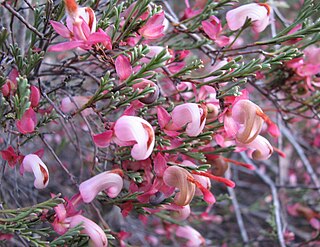
Grevillea involucrata, also known as Lake Varley grevillea, is a species of flowering plant in the family Proteaceae and is endemic to the south-west of Western Australia. It is an openly-branched, prostrate or low-lying shrub with divided leaves with parallel, oblong to linear lobes, and pink flowers with a pinkish-red style.

Grevillea pilosa is a species of flowering plant in the family Proteaceae and is endemic to the south-west of Western Australia. It is a spreading to prostrate shrub with wedge-shaped to oblong leaves with sharply pointed, more or less triangular teeth or lobes, and clusters of pale pink to rose-pink or red flowers.
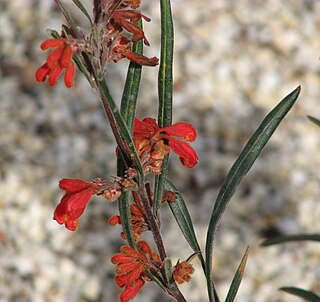
Grevillea bronweniae is a species of flowering plant in the family Proteaceae and is endemic to the south-west of Western Australia. It is an erect shrub usually with more or less linear leaves, and wheel-like clusters of crimson flowers.

Grevillea pinaster is a species of flowering plant in the family Proteaceae and is endemic to the south-west of Western Australia. It is an erect shrub with linear leaves and pinkish-red to red flowers, the style with a yellowish tip.
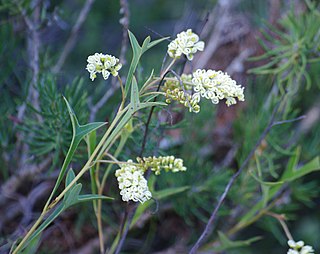
Grevillea synapheae, commonly known as catkin grevillea, is species of flowering plant in the family Proteaceae and is endemic to the southwest of Western Australia. It is a prostrate to erect shrub usually with divided leaves with 3 to 7 triangular to more or less linear lobes, and clusters of white to creamy yellow flowers.

Grevillea diversifolia, the variable-leaved grevillea, is a species of flowering plant in the family Proteaceae and is endemic to the south-west of Western Australia. It is an erect to prostrate shrub with simple or divided leaves and groups white to cream-coloured flowers with a dull red style.
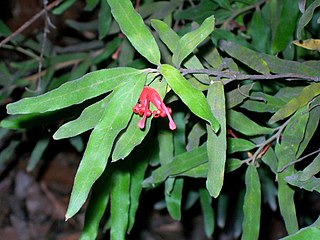
Grevillea mollis, commonly known as soft grevillea, is a species of flowering plant in the family Proteaceae and is endemic to a restricted area of north-eastern New South Wales. It is an open, spreading shrub with oblong to elliptic leaves and loose clusters of bright scarlet red flowers.

Grevillea quercifolia, commonly known as the oak-leaf grevillea, is a species of flowering plant in the protea family and is endemic to the southwest of Western Australia. It is a straggly to sprawling shrub usually with pinnatifid or serrated leaves, and oval to cylindrical clusters of pale to deep pink flowers.

Grevillea exposita is a species of flowering plant in the family Proteaceae and is endemic to the south-west of Western Australia. It is a dense, spreading shrub with mostly oblong to narrowly elliptic leaves and clusters of bright red and white flowers.

Grevillea evanescens is an endangered species of flowering plant in the family Proteaceae and is endemic to the south-west of Western Australia. It is an erect to spreading shrub with oblong to elliptic leaves and clusters of pale to bright red and cream-coloured flowers.

Grevillea kenneallyi is a species of flowering plant in the family Proteaceae and is endemic to the south-west of Western Australia. It is a dense, spreading shrub with divided leaves, the end lobes more or less linear, and clusters of white flowers.

Grevillea refracta, commonly known as silver-leaf grevillea, is a species of plant in the protea family and is native to northern Australia. It is a tree or shrub usually with pinnatipartite leaves and red and yellow flowers arranged on a branched, downcurved raceme.
Grevillea crassifolia is a species of flowering plant in the family Proteaceae and is endemic to the south-west of Western Australia. It is an open shrub with often thick, elliptic to oblong leaves and red flowers.

Grevillea minutiflora is a species of flowering plant in the family Proteaceae and is endemic to the south-west of Western Australia. It is a shrub with many branches, tangled, divided leaves, the end lobes more or less linear, and cylindrical clusters of creamy-white flowers.
Grevillea murex is a species of flowering plant in the family Proteaceae and is endemic to a relatively small area of south-western Western Australia. It is a spreading, much-branched shrub with hand-shaped leaves and clusters of greenish-white to dull cream-coloured flowers.


















